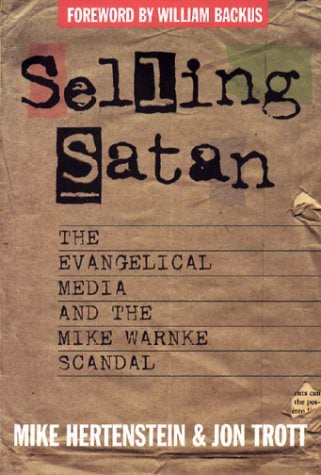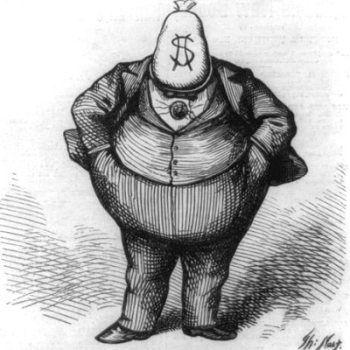Selling Satan is a terrific book — one I’ve recommended countless times over the years on this blog. It’s the work of two devout white evangelicals who became accidental investigative journalists, and very good ones at that.
The book started when Mike Hertenstein and Jon Trott were working for Cornerstone magazine, the publication of Jesus People USA, an intentional Christian community in inner-city Chicago. The name “Cornerstone” was best known for JPUSA’s wonderful annual music festival — the closest thing American Christians had to Greenbelt. JPUSA’s little magazine was best known for its music reviews and profiles of Christian-but-still-actually-good artists and bands.
 In 1990, Hertenstein and Trott started looking into the claims made in “Lauren Stratford’s” explosive best-seller, Satan’s Underground, a purported memoir of her years imprisoned by a secret cult practicing Satanic ritual abuse. Searching for evidence to support Stratford’s claims, they found there wasn’t any.
In 1990, Hertenstein and Trott started looking into the claims made in “Lauren Stratford’s” explosive best-seller, Satan’s Underground, a purported memoir of her years imprisoned by a secret cult practicing Satanic ritual abuse. Searching for evidence to support Stratford’s claims, they found there wasn’t any.
This was at the height of the Satanic Panic — a time when everybody just kind of knew that stories like this were real and true and unquestionable. Courts of law were sending people to prison for their alleged involvement in these Satanic cults and shows like 20/20 were broadcasting national reports warning of the danger, all drawing on “evidence” from books like Satan’s Underground. And here was this tiny magazine from a hippie-Jesus commune teaching itself to do actual investigative journalism and calling the whole thing into question.
Stratford’s fake memoir built on the best-selling earlier work of “Christian comedian” Mike Warnke. Warnke’s comedy albums sold more copies for the big Christian-brand record labels in Nashville than nearly all the bands who played Cornerstone put together. He was a much bigger Christian celebrity — more of a rock star — than JPUSA’s own respectable rock act, the Resurrection Band. But Warnke wasn’t best known for his jokes (the best of which weren’t his). His biggest claim to fame was that he had once been a High Priest in the Church of Satan. His stand-up sets always included thrilling, lurid stories of the occult rituals and sacrifices he had participated in — before he found Jesus and got saved, of course. Warnke’s own memoir collecting all of those first-hand tales of Satanism had been a runaway best-seller and a huge money-maker for its Christian publisher.
Once Hertenstein and Trott realized that Stratford’s repackaging and supposed confirmation of Warnke’s stories was an easily debunked pile of obvious fabrications, they began to question the legitimacy of his claims as well. It didn’t take much investigation for them to begin to see that nothing in Warnke’s story held up. Basic chronology and geography made most of his claims impossible, and as he responded to the most basic questions with evasion, defensive anger, and more easily disproved lies, the duo from C-stone were able to unravel the whole giant fraud, proving that none of it was true.
Their book debunking Warnke and the Christian media industry that propped him up and profited from his scam is a fascinating read in part because Hertenstein and Trott are so nice. I once joked here that it’s like reading All the President’s Men if it were written by Rod and Todd Flanders. They’re scrupulous and determined to find the truth, doing all of their homework and their legwork, but you never get the sense that you’re reading a hatchet job by people determined to “take down” Warnke. The overwhelming evidence of his fraud and his brazen lies is presented with a genuine sadness and disappointment for Warnke himself and for his audience — for the millions of Christians he deceived.
Hertenstein and Trott don’t flinch from the unavoidable conclusions of their reporting. Warnke lied and made a fortune from lying. Lots of other Christians also profited from his lies and many of them — from his publisher, his Christian-brand record label, and from the hundreds of churches and coffee houses that hosted his sold-out tours — must have known he was lying.
That was the point of the book’s subtitle: “The Evangelical Media and the Mike Warnke Scandal.” Warnke’s lies turned out to be so obvious and unsupportable that they must have been an open secret among all of the devout Christian organizations promoting and profiting from his “born-again former Satanic high-priest” act. H&T piled on their research to disprove his story with mountains of evidence, but most of that was overkill. Warnke’s timeline simply didn’t add up. Anybody paying attention to the story he was telling had to realize, on some level, that he was debunking himself.
Which brings us to my only frustration with this book: It demanded a sequel. The work Hertenstein and Trott did to expose and indict those “Selling Satan” was so revealing that the reader couldn’t help but wonder about Warnke’s audience — about the millions of Christians who had, for years, been enthusiastically Buying Satan.
Was that mass audience eagerly devouring his lurid story really deceived by his transparent fraud? The obvious gaps and discrepancies and contradictions in Warnke’s account must have raised red flags and questions. It’s not hard to understand why Warnke’s publisher and record label chose to pretend not to see all those discrepancies — Logos International and Word Records were making tons of money from Warnke’s lies, so it was in their financial interest not to examine his story too closely (or at all). But his audience wasn’t making money from this. They were, rather, choosing to pay for it.
Why? What was in it for them? Why were they willing to push aside their own rational objections, suspend their own disbelief, and spend their own money to indulge in his fraudulent nightmare fantasies?
Those questions are something I’ve pursued and reflected on and obsessed over for many years here on this blog — see the “Satanic baby-killers” tag for example. But I always wondered if Hertenstein and Trott wondered the same thing.
Well, it turns out that Mike Hertenstein did. And he’s been busy.
I missed this piece when Hertenstein first posted it in 2018:
This story showed up on my radar in the years following my experience reporting on the then-raging “Satanic Panic” in the early 1990s, when I wrote for Cornerstone magazine. Cornerstone’s work on Satanic Panic helped put the brakes on the Panic. … During that time, I was co-author, with Jon Trott, of an exposé and later the book Selling Satan: Mike Warnke and Evangelical Media, about a religious entertainer whose story of being a Satanist high-priest was proven fabricated. That experience got me interested in various related topics, and made me sensitive to Evangelical discourse that attributed nefarious deeds and conspiracies to devil-worshipers. As time went on, I got particularly interested in the political uses of such discourse.
The story Hertenstein refers to there isn’t about some fringe figure from cable TV or the tent-revival circuit. It’s about Billy Graham and Richard Nixon going full-gonzo Q-Anon Blood Libel in the Oval Office in 1972.
This story was already public knowledge, sort of. Hints and excerpts of the full White House conversation between the president and the evangelist had trickled out over the years, prompting denials and apologies and PR spin that gradually coalesced into a kind of official version of the story. And that official version was bunk.
We know this now because, Lordy, there were tapes. But those tapes wouldn’t be available as long as Billy Graham was alive, and would only be made available after his death to anyone who knew to ask for them.
Fortunately, Mike Hertenstein is still pretty good at the grunt-work of investigative journalism:
The “Synagogue of Satan” language used by Billy Graham caught my attention more recently as I came across references to it while researching the Evangelical discourse of demonization, working on a theological studies degree at North Park Theological Seminary. In the course of that work, I looked into the story of the Nixon conversation and noticed that there was still material to be released. I later sent out a series of Freedom of Information Act requests to the National Archives. These were turned down: the Nixon tapes, for various governmental reasons, are not subject to FOIA requests.
This application and appeals process put me in contact with Cary McStay, an archivist at the Nixon Library, who helped me jump through the requisite hoops to make a formal request that the material on “Conversation №662–4” be recategorized. That process put me at the head of the line when Billy Graham died in February of 2018 — and so finally moved forward the process.
Billy Graham’s death at the age of 99 was front-page news all over the world in 2018. Religion reporters rushed to insert the final details into their long-prepared obituaries and to conduct the interviews with all of the leaders, scholars, and experts needed to put this monumental life into perspective.
But Mike Hertenstein was doing something else, reaching out to an archivist he’d befriended years before to at last secure the answers he’d been patiently seeking for years — the full, unedited Graham-Nixon tapes of “Conversation No. 662-4.”
This whole post, in a sense, is just background — the story behind the story and an appreciation of the long, patient, determined, and detailed work it took for Hertenstein to get to the truth here.
But I also felt it was important to provide this background as a kind of deep breath before plunging into the ugliness of “Conversation No. 662-4.” It’s bad. It’s worse than you think, even if you’re anticipating that it will be worse than you think.
We’ll get into that here shortly, but if you want a preview, see Hertenstein’s July 28. 2018 post “Billy Graham & the Synagogue of Satan: Lost Passage of Infamous Nixon Tape Makes a Bad Story Worse.” Or see John Fea’s summary and reaction here.
This may seem esoteric. And stories like this tend to get swatted away with distracting nonsense shifting the focus to considerations of “reputation.” But this isn’t about reputation. Nor is it only about two dead-and-buried power-brokers from the previous century.
It’s about next month’s elections. Billy Graham and Richard Nixon may be dead, but the toxic fantasies they affirmed are still alive and thriving. Those vicious, evil lies are — right now, today — running for governor of Pennsylvania, and of Arizona, and of Michigan. They’re seeking control of the House and Senate. And they’ve got a real shot at winning.












